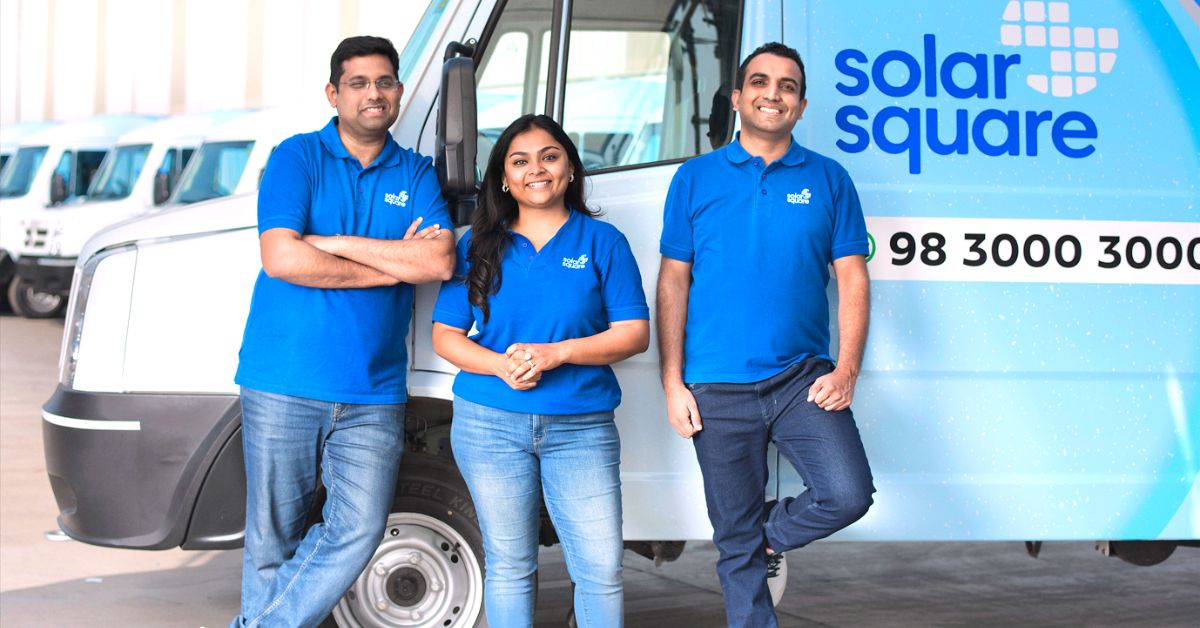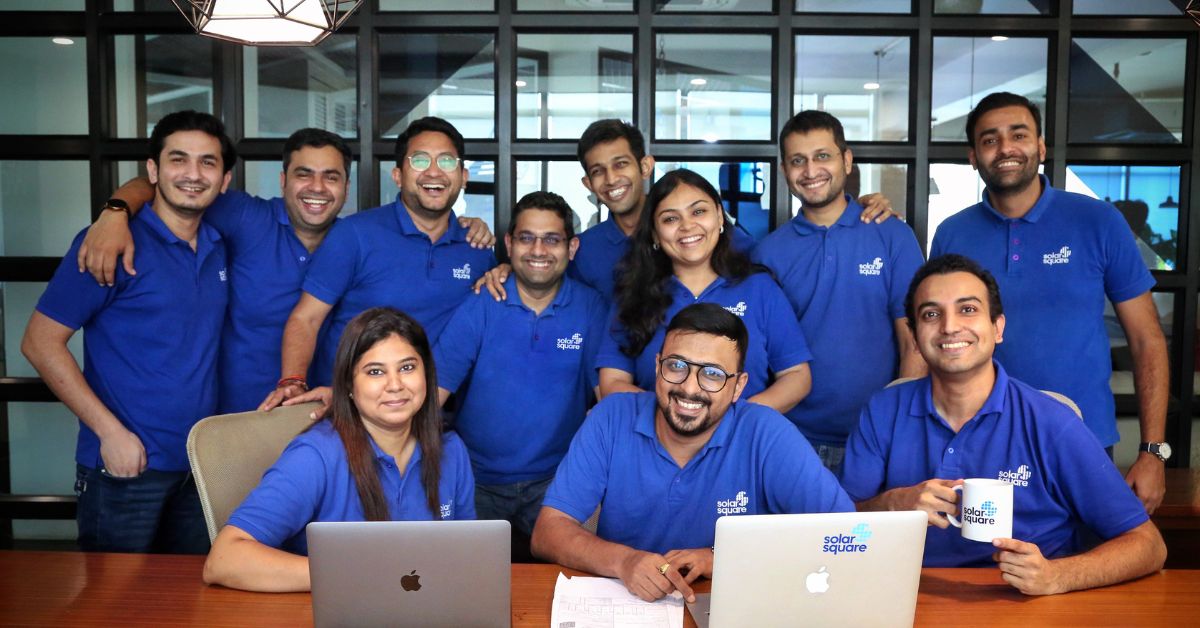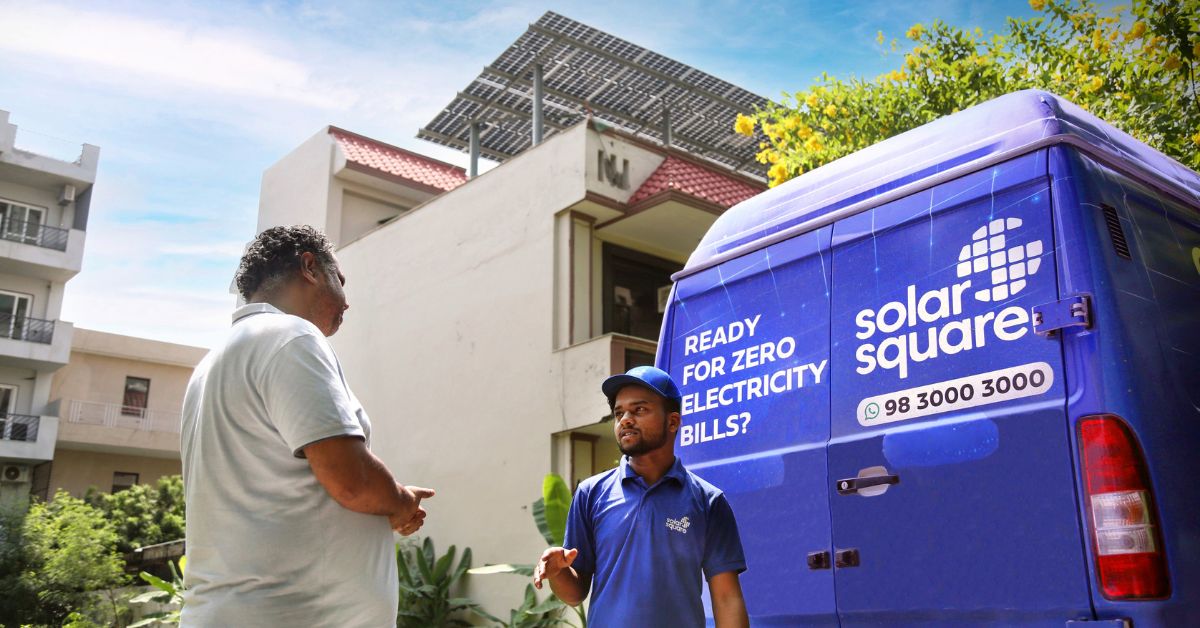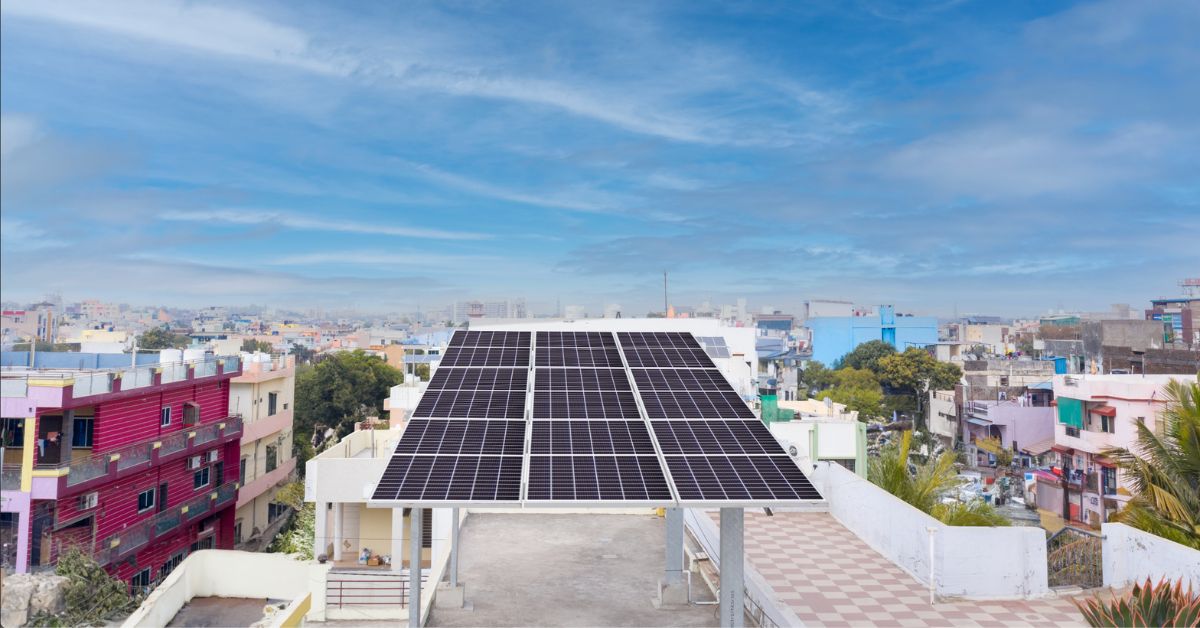Startup by IIT Grads Helps Indian Homes Run on Zero Electricity, Earns Rs 200 Crore in Revenues
SolarSquare, founded by IIT Bombay graduates Neeraj Jain and Shreya Mishra, along with Pune University graduate Nikhil Nahar, is a leading residential solar brand. They have educated thousands of consumers and standardised installation of solar panels in 16 cities spread across eight Indian states.

In late 2020, entrepreneurs Neeraj Jain and Nikhil Nahar made a decision that would confound most entrepreneurs. Despite running a Rs 100 crore bootstrapped and profitable startup centred on setting up solar power installations for large corporations since 2015, they decided to make, what many felt at the time was, a risky pivot towards the (B2C) residential solar segment.
To help them make that pivot, Neeraj roped in fellow entrepreneur and IIT-Bombay graduate Shreya Mishra, who had prior experience of running a consumer business.
“Neeraj and Nikhil were only 26 and 27 respectively when they founded SolarSquare in 2015. In the same year, I founded Flyrobe, a fashion rental startup. It was very different from the world of solar energy. I sold my startup in 2019, and in the following year, my husband Neeraj convinced me to join SolarSquare. He was an engineer with banking experience but wanted to do something with deep meaning and purpose. While he had a good grasp of the solar market, he wanted my expertise in building consumer businesses. That’s how we started experimenting in the residential solar segment, which is more B2C,” recalls Shreya, co-founder of SolarSquare.
This was going to be a tough pivot because the industrial segment is very different. As a company in the commercial and industrial segment, SolarSquare was setting up massive and customised solar power installations worth a few crores for Fortune 500 companies. This is unlike the residential sector where they are dealing with individual homeowners.
“Neeraj and Nikhil took a very bold call to experiment in the residential solar segment because they understood the massive business opportunity it offered at a time when no organised company in the solar energy space saw it. They saw that the residential solar segment looked like the opportunity of the future. If they were to commit to this, they had to focus all their energies on it. That was a major inflexion point,” she adds, speaking to The Better India.
The residential solar segment presented the opportunity of the future because average Indian households were struggling with rising electricity bills thanks to increasing tariffs and regular incidences of extreme weather conditions. Rising electricity costs in many states made it imperative for consumers to explore alternative solutions. One viable solution for individual homeowners and residential societies was to adopt rooftop solar power installations.
As Shreya explains, “For the residential segment, we’ve built a lot of standardisation in solar installations that has allowed us to scale. Imagine doing tiny solar installations that are customised to each home! It’s too complex a process for a B2C operation. We standardised everything and made prefabricated ready-to-install solar kits, which get installed in just six hours. In other words, we underwent a lot of learning innovation for this segment.”
Barely three and half years later, SolarSquare has emerged as a leading residential solar brand in India with a consumer base of more than 10,000 individual homeowners and over 100 residential societies. As Shreya claims, “A lot of serendipity led us here. Today, we are operational in 16 cities spread across eight states. Over two rounds of funding, we have raised about Rs 130 crore and we’ll be doing close to Rs 200 crore in revenues in this financial year.”
Even though about 20% of SolarSquare’s business still lies in the commercial and industrial solar segment, they’ve pivoted close to 80% of their business towards the residential segment. In the process, they have also doubled in size as a business — a significant feat.
“Today, 80% of our business is in the residential segment where we work with individual homes (2BHK, 3BHK) and residential societies. RWAs buy solar power installations for their common areas like lifts, water pumps, street lights, etc. Many of the high-rise apartments you see in Mumbai, Pune, and Bengaluru are SolarSquare customers,” she adds.

Overcoming doubt
In January 2024, Prime Minister Narendra Modi said that the Union Government had set a target of installing rooftop solar in one crore households over the next few months. When SolarSquare decided to pivot to the residential solar segment in late 2020, this major market opportunity wasn’t apparent.
“Even families weren’t aware of the benefits of solar. People didn’t know the basics. Many people confuse rooftop solar installations with water heaters. They didn’t know you could power your home with solar. There were a lot of myths and misconceptions that needed to be addressed and awareness levels were very nascent,” explains Shreya.
SolarSquare’s first mandate was to create a brand on the back of “educational marketing and trust.” To that end, they published videos, content, and blogs, and worked with influencers to create awareness. They have also published a free homeowner’s guide to going solar.
“Before installing anything, we will help a homeowner understand why solar is good for them and what kind of solar installation is good for their home. We decided that we would first educate people before selling them anything. See, there was rampant mis-selling in this industry. Residential solar is a fragmented and unorganised market involving a lot of local operators who do this as a side business. People were sold second hand or rejected panels because they didn’t know how to authenticate warranty or quality of products,” explains Shreya.
“Also, many were sold solar power installations without after-sales service. If you are buying solar, buying the right after-sales service is very important because, without it, your investment goes down the drain. We had to educate people about these things,” adds Shreya.
The next biggest challenge for SolarSquare was convincing potential investors that their decision to foray into the residential segment made business sense.
“When we went out to raise funds, potential investors thought that residential solar is a small market. Most of them were more engaged in fintech and e-commerce. They felt that residential solar was a very brick-and-mortar business where you have to go from one home to another, educate people, close an order, install panels at their homes, and maintain them for years. Nobody understood this market and its potential,” says Neeraj.
Speaking to Forbes India in June 2022, Shreya claimed that residential solar was a ‘$50 billion opportunity’ based on her estimates. It was a very bold claim back then given how international market research and advisory companies like Custom Market Insights estimated that the entire Indian solar energy market was worth $38 billion in 2022.
“Looking back, I probably wildly underestimated the market. With one crore homes potentially going solar in the next three years, this market will probably see $25 billion. In a decade, this could very well be a $75 billion to $100 billion market,” claims Shreya.
“It’s a unique time in history where you can create a consumer brand in energy. Otherwise, energy has always been the game of large corporations and Government-owned power plants. Energy is now personal and private, and we can create a consumer brand around it. Investors took a lot of time to build their understanding of the possibilities in this market,” she adds.

How to go solar with SolarSquare?
So, how can a homeowner in India install solar power in their homes with SolarSquare? A journey with them begins with registering an inquiry either on their website or WhatsApp. Once customers register a query, SolarSquare sets up a ‘free solar consultation’.
“Our solar consultant, a trained expert, will visit your home, survey your roof, understand your electricity requirements, study your electricity bills, and guide you to the right solar solution for your home. They will also explain how solar power works, what are the different technology choices available, etc. We consult the customer with the right solution for their home, answer all their queries, and only then comes the question of selling anything to them,” claims Neeraj.

Also, many consumers understand the benefits of going solar. Whatever money they put into installing solar, they’ll recover their investment in three to five years depending on the electricity tariff and then enjoy 20 to 22 years of free electricity. However, the initial investment of Rs 2 lakh to Rs 3 lakh to install a rooftop solar system is often difficult for most middle-class families in Indian cities.
“During this consultation, we also take the consumer’s PAN card, check his loan EMI eligibility, and present the EMI schemes we can offer to them. People can go solar on a six-month zero-cost EMI, 12-month EMI, or 60-month EMI. That makes it an affordable proposition. Also, in case of 60-month EMI, their initial down payment to us gets covered through the subsidy given by the Union Government,” claims Shreya.
To power a 2 to 3-BHK home that doesn’t have air conditioners, a consumer will need a 3-kW to 4-kW solar installation. If such homes have an air conditioner, they may require 5-kW to 6-kW.
“The most commonly sold residential rooftop solar installation is 3-kW. A solar kit for this energy requirement is about Rs 2 lakh, of which the Government covers Rs 78,000 as a subsidy (under the latest ‘PM-Surya Ghar: Muft Bijli Yojana’). The consumer ends up paying only about Rs 1.2 lakh,” she explains.
“On this 3-kW system, consumers end up saving Rs 3,000 to Rs 3,500 a month in electricity bills. In a year, this amounts to approximately Rs 36,000 to Rs 40,000 a year in electricity savings. In about three to four years, you can recover all your initial investment. Following this, this solar installation can give you free electricity for the next 20 to 25 years,” she adds.
“For the consumer on a five-year EMI, their net investment comes down to zero because their down payment gets covered by the subsidy given by the Union Government, and monthly EMIs are covered through monthly electricity savings achieved after going solar. In net terms, the family doesn’t even have to arrange any substantial sums. We call this the zero investment scheme of solar, which we educate the consumer about during a consultation,” says Neeraj.
Once the family (consumer) decides to book their services, the startup draws up a detailed technical design, takes care of all their Government permits, and applies for their subsidy. After the consumer has approved the final design, they pay an advance which is covered by the subsidy, and then, the company delivers their ready-to-install solar kit.
“Our ready-to-install kit includes our trademark Wind Pro Mount elevated structures, which are also known as module-mounted structures. Measuring about six feet tall, these structures are the backbone of our installations holding up the panels. These structures are very sturdy, come with a 10-year warranty, zero-rust guarantee, and certification from IIT-Bombay that even during a cyclone with wind speeds of up to 170 kmph, nothing will happen to the rooftop solar structure,” she says.
“See, these solar installations are subject to external weather, elevated, and on top of a roof, and subject to high wind speed pressure. They have to be durable. We install our solar kit in just six to seven hours. Once installed, the customer requires an inspection from their local power discom. Once the site is inspected, their final bank details are uploaded on the Government portal and the subsidy comes into their bank account within just 30 days,” notes Nikhil.
The Union Government recently launched the National Portal for Rooftop Solar on the back of which all of these Government subsidies and applications are done.
“We take care of all these applications for the consumer. We take care of Government permits, subsidy applications, EMI applications, inspections, design, procurement, etc. We are a full-stacked brand that offers end-to-end solutions for the Indian consumer,” says Shreya.
Following installation comes the most important part — after-sale service. India is a country where roofs are subject to a lot of dust and a variety of external weather conditions. These elements cause a lot of wear and tear on rooftop solar panels.
“We offer a five-year comprehensive solar care plan in which we take care of everything from panel deep cleaning to technical, mechanical, and electrical maintenance. Once installed, it’s your roof and solar energy but our responsibility. As a policy, we sell a five-year comprehensive solar care plan so that consumers can enjoy the benefits of zero-electricity bills year after year. Consumers can renew their after-sale care plan with us after these five years,” notes Neeraj.
“If you look at rooftop solar systems as an investment, you’re seeing 20-25% IRR (internal rate of return) if it gives you the right performance. Maintenance is important because that’s how you realise that 20-25% IRR. Every month or three months, a trained SolarSquare technician will come to your home, do a complete technical check, electrical maintenance, and mechanical check, and do a deep cleaning of the solar panels to ensure any hard dust or bird droppings are removed. Following this check, you will see a spike in power production,” claims Shreya.

Looking to the future
One of the biggest challenges moving forward for companies like SolarSquare will be managing solar panels that reach the end of their lives. These discarded panels are often left strewn around or eventually get mixed up with domestic solid waste and end up in landfills.
According to a report by the International Renewable Energy Agency, “large amounts of annual (solar panel) waste are anticipated by the early 2030s” and could touch 78 million tonnes by 2050. Shreya, however, believes there are ways to extend the lives of these used panels.
“If you maintain your rooftop solar installation well, it can last up to 30-35 years. So, once a consumer retires their solar rooftop system, they can donate the panels to non-profits working for a worthy cause. These panels can run for another 10 years because they’ve been maintained so well. These solar panels can have a second-hand life too,” she notes.
But she does admit that ventures like SolarSquare will have to devise comprehensive plans to recycle decommissioned panels. “Since we are only a nine-year-old company, we don’t have any solar installations that have reached the end of life. The question of disposal and recycling is important. Thankfully, you already have companies in the US that can recycle 70% of the components and materials used to make solar panels,” she says.
In India, meanwhile, a team of researchers at the Centre for Sustainable Technologies (CST), led by Dr Monto Mani and operating out of the Indian Institute of Science (IISc) in Bengaluru, is exploring whether old discarded solar panels can be upcycled as a building material. With this, they are looking to extend the panels’ useful life by a few decades.
However, in terms of their future as a business, things look good.
In December 2021, they raised Rs 30 crore in their Seed round. During their Series A round in October 2022, they raised Rs 100 crore. “Lower Carbon, one of the world’s largest climate tech funds, is our shareholder. It was their first investment in India. We also have Elevation Capital, who are investors in Swiggy and Urban Company, and other notable investors on board,” she says.
Moreover, according to a November 2023 report by the Council on Energy, Environment and Water (CEEW), more than 25 crore households in India have the potential to deploy 637 GW of solar energy capacity on rooftops. According to a Times of India report on the same, “Further, the CEEW report found that deploying just one-third of this total solar technical potential could support the entire electricity demand of India’s residential sector (~310 TWh).”
For ventures like SolarSquare, the opportunities are massive and the future looks promising. If you found our stories insightful, informative, or even just enjoyable, we invite you to consider making a voluntary payment to support the work we do at The Better India. Your contribution helps us continue producing quality content that educates, inspires, and drives positive change. Choose one of the payment options below for your contribution- By paying for the stories you value, you directly contribute to sustaining our efforts focused on making a difference in the world. Together, let’s ensure that impactful stories continue to be told and shared, enriching lives and communities alike. Thank you for your support. Here are some frequently asked questions you might find helpful to know why you are contributing?

(Edited by Pranita Bhat; Images courtesy SolarSquare)
Sources
Homeowner’s Guide to Buying Rooftop Solar by SolarSquare
‘SolarSquare’s co-founders on the $50 billion opportunity to bring solar power to Indian homes’ by Harichandran Arakali; Published on 14 June 2022 courtesy Forbes India
‘India Solar Energy Market 2023–2032’; Published in May 2023 courtesy Custom Market Insights
‘India has 637 GW of residential rooftop solar energy potential: CEEW report’ by Hemali Chhapia; Published on 17 November 2023 courtesy Times of India
This story made me
-
97
-
121
-
89
-
167
















